Parking our car got a little more scenic this weekend with the completion of our carport pergola. Or, cargola (pergolaport?) if you will.
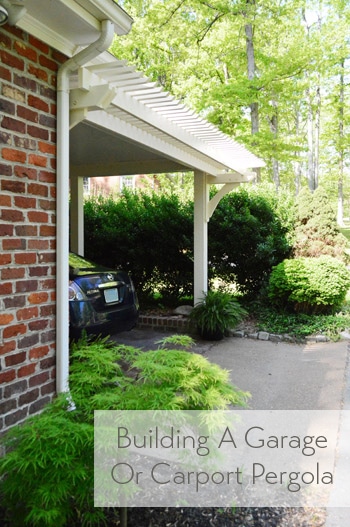
Last week we talked about dressing up our carport with the help of some pergola plans from Workbench Magazine. The plans took a lot of the guesswork out of it, but there was still plenty of actual work. All-in-all it took about 4.5 days of work (the half day was spent picking up the materials, which we talked about here) but I’m gonna boil it down to one simple post. So here we go.

What you need to know is that there were four main parts to this building project: 1) the column, 2) the braces, 3) the joists, and 4) the lath.
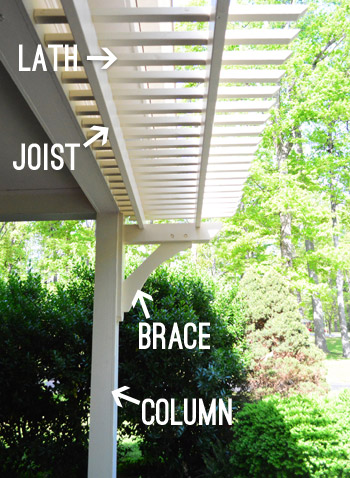
Most attached pergolas don’t have the column in the equation (they just attach to the walls beside or above a garage door or a french door), but because our carport only had posts on the left side (see below) our first assignment was to add one on the right to add symmetry and create a place for the pergola to attach.
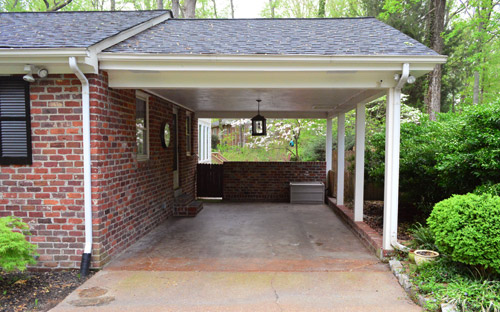
To attach a post to our concrete floor, we used this post base which is built for situations like this. And I got to break out my hammer drill to make a pilot hole for the concrete anchor, which was a good time. I bought the hammer drill back when I was starting the deck, but never ended up using it, so I’m glad I had it around because I needed it’s drill-plus-hammer motion to get through the concrete. Then I hammered in a wedge anchor and tightened the nut to keep it in place.
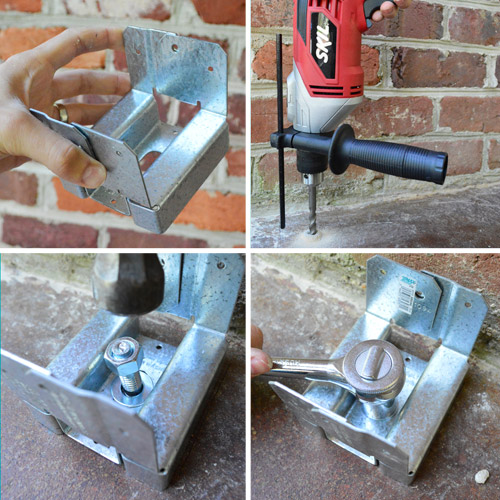
I attached another metal post base on the ceiling (this time just using heavy-duty screws) so that we could slide a 4 x 4″ post right in there and nail it into place.
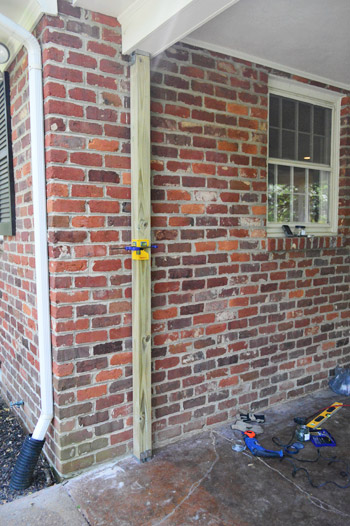
Since that post is neither very attractive or big enough, we used the same method as we did when we beefed up our porch columns. They didn’t sell any pre-primed pine in long enough boards, so we primed and painted the two 1 x 6″ and one 1 x 4″ boards before hanging them. Here I am using our nail gun to attach the boards in place and give the column a chunkier look.
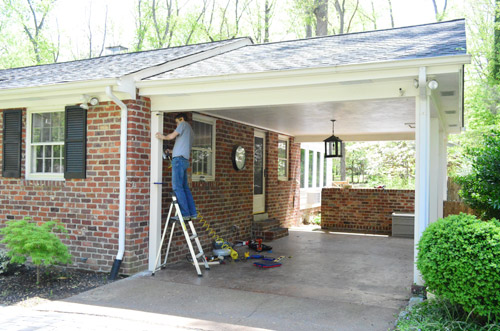
After we caulked the seams and added some touch-up paint, our first of four steps was officially checked off the list. And I should add that this took me the better part of my first day (with occasional “hold this with me” and “take a picture of this step” and “help me paint while Clara naps” assistance from Sherry).
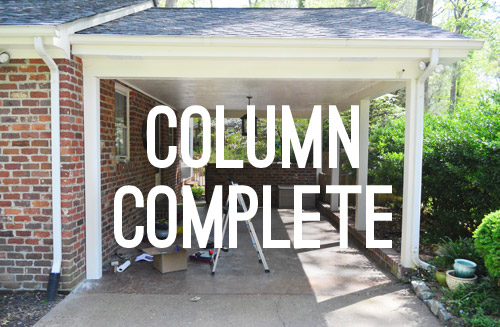
The other part of day one was spent getting started on my braces (or “knee braces” if I’m feeling formal). These were by far the most complicated of all four steps, since there were four sub-step when it came to building each one. We originally hoped to purchase these pre-made, but we couldn’t find any in the size that we needed. In the end, I’m glad I made them because it was much cheaper.
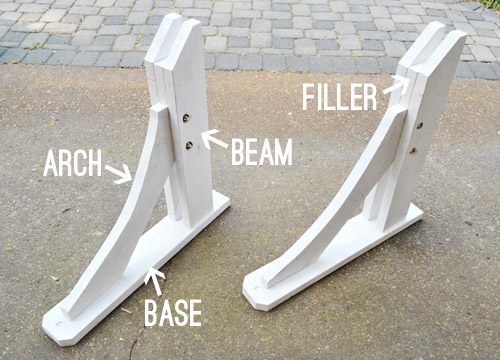
Some of the braces that I saw online were going for $50 – $100 a piece, depending on the size. Each of mine were made from one single 12 ft piece of 2 x 6″ and a few bolts, making mine about $22 each. So the first step was to cut my 2 x 6″ into the lengths that my plans called for. Burger double-checked my work.
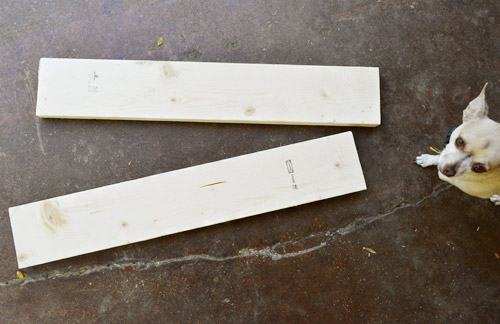
First up was what I’m calling the “base” (the part that rests against the column). They were pretty straightforward. I cut some decorative notches on the bottom with my miter saw and then used some hole-boring bits to make a few places on each side to countersink my bolts. Again, my plan took a lot of the mystery out of what to do, but it was still a bit tedious.
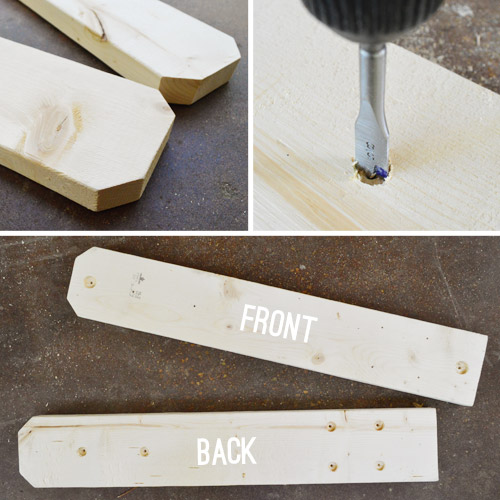
The next pieces I tackled were the “beams” – the parts that would stick out from the base at a 90° angle. They were really easy, which was lucky because I had to make four of them. I actually clamped two together when I made the cut so that I’d be sure the beams that got paired together on the same brace were absolutely identical.
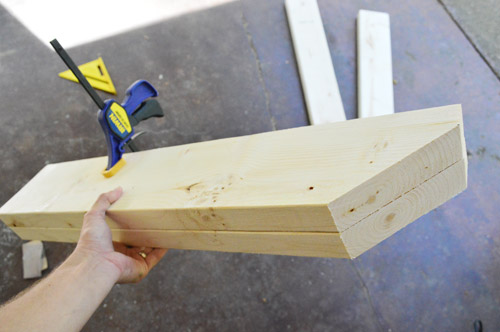
With the easy stuff out of the way, I turned my attention to the “arch.” Yes, a dreaded curved cut. Cue the dramatic music. To mark my curved line, I tapped some temporary nails into the wood at both ends and at the middle/top of my curve. Then I used a thin piece of scrap wood (a small piece of PVC works too) and bent it over my nails to create an arched shape. That held long enough for me to mark the curved line between my two nail-points.
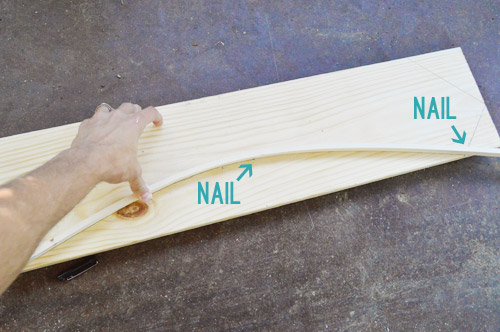
Next was the challenge of actually cutting that line. Since I don’t own a scroll saw, I had to rely on my jigsaw. It did the job okay, but since it’s sometimes hard to keep the blade perfectly vertical, my arch had a couple of wonky spots (not majorly wonky, but wonky enough that I noticed them) so we sanded the heck out of it to try to smooth things out.
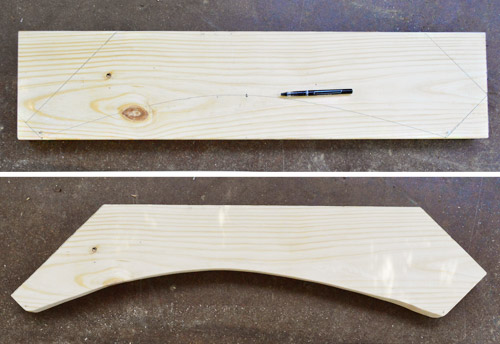
After some vigorous sanding they were a lot better looking, and some primer further cleaned things up (we primed all of our brace pieces together once they were all cut out).
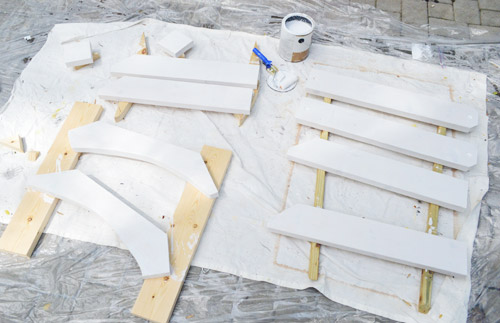
Then we had to assemble them. It was a tricky system of clamps, temporary nail gun nails, and balancing on scrap wood pieces to get it done, so don’t even try to make sense of this picture (it’s upside down, if that helps).
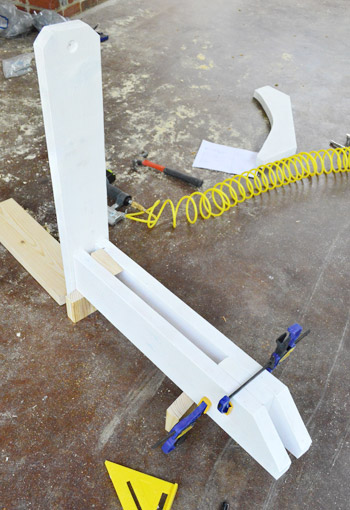
Basically we had to get both of the beams and the single arch piece aligned (and centered and level) and then screw them to the base using some 3″ lag bolts. It took a bit of finesse to get it all done without attaching something slightly crooked, but eventually we got the job done.
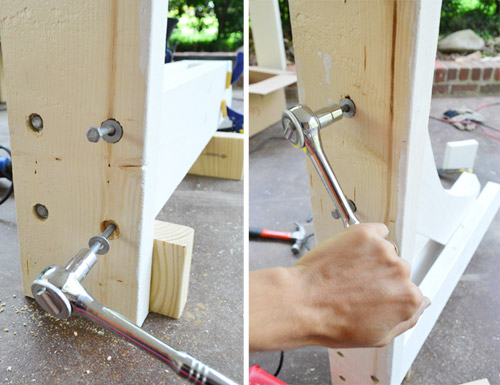
Then we had to drive some bolts through two beams (and the portion of the arch that sat between them). It sounds very straightforward, but the process took me a while and the rest of the day was spent rerouting a gutter and outdoor light fixture. So by the end of day two we had built two braces, but I couldn’t call this step complete since they were neither painted (that happened the next morning) nor hung (which also got done the next day).
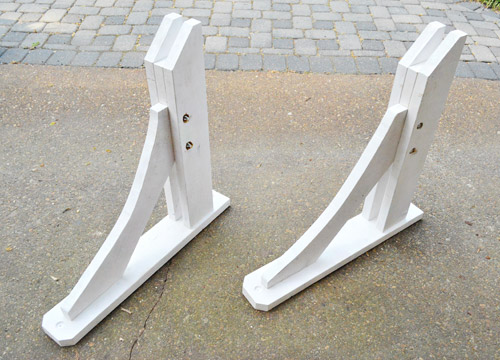
Hanging them took some finesse too, mostly because one of us had to hold the weight of it while the other checked that it was level and temporarily nailed it into place. There’s no way brad nails would support the weight of it over time, but they kept each brace in place long enough for us to drive a lag bolt into the top and bottom of each one, which secured it for the long haul.

By noon on day three we were finally ready to move on to step 3.

Step 3 was the joists. You know, those two long pieces that would rest on each of the braces. These were again made from 2 x 6″ board and again they required a decorative curved cut (marked below). We did the curve on just the left side since on the right side they’d butt up against the side of the house.
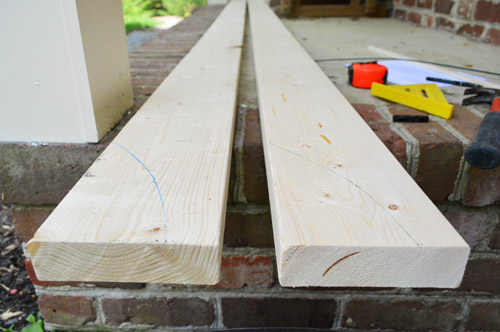
Once they were cut, we hoisted them into place and marked the exact spot where they rested on the braces.
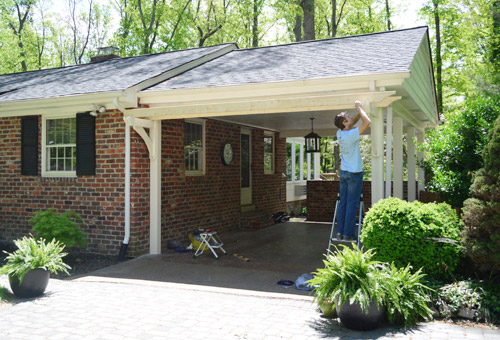
These marks showed me where we needed to cut notches in the joists so they’d sit tight on the braces. And while we had them down, we also primed and painted them.

While the paint dried I got started on step 4, so it wasn’t until the next morning that we could actually hoist them into place. As for how we screwed them into place, we basically drilled a long pilot hole through the top of each joist and used a long drill bit to screw right through the top of the joist and into the brace’s beam below.
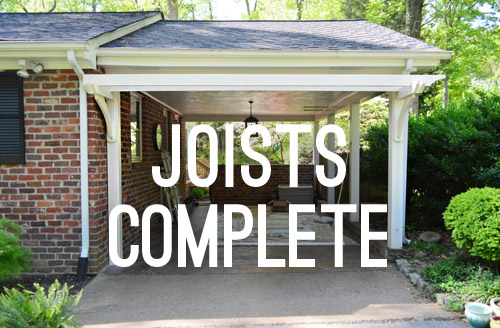
The last step was the lath, or the small strips that create the rail across the top. Since we were going to paint ours I couldn’t use the pre-cut pressure treated 2 x 2″ pieces that they sell pre-cut for deck railings (they say pressure treated lumber should be allowed to “dry out” for a number of weeks before paint or stain traps the treatment’s moisture in – and we wanted to paint things right away). So we bought regular 2 x 2″ boards that were 8 feet long and cut them down at home. This ended up being substantially cheaper, but we needed 50 of them (including a few just-in-case extras) so cutting and sanding them took me a good two hours. It was not exactly fun, but it was nice and mindless. Then came priming and painting all. those. pieces.
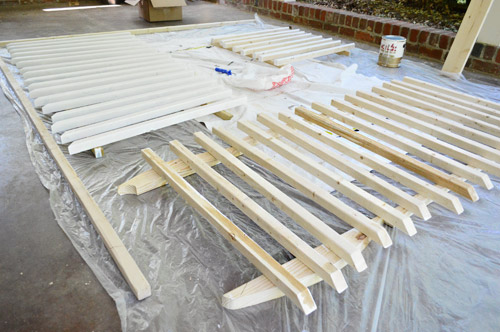
We had to cover all four sides of them since they’d all be seen, so thank goodness the paint had good coverage and it only took one coat (it’s Benjamin Moore Exterior paint leftover from the previous owners). Once everything was dry, we could start putting the lath into place on top of the joists.
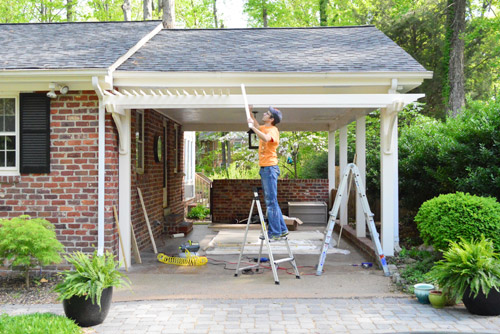
This was the point that we both started to get giddy because the pergola was actually starting to look like a pergola. Oh and we cut a few 3-inch wide “spacers”out of scrap wood to help us keep our gaps even so we could screw them into place as quickly as possible (see the two longer unpainted boards in the picture below?).
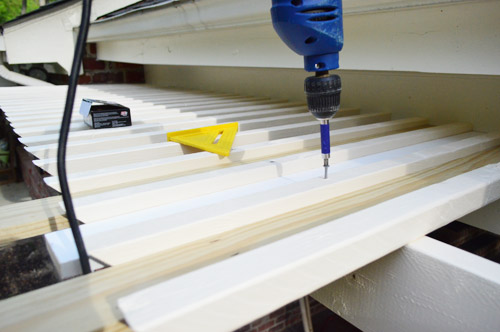
By the end of day four, step four was 100% done.
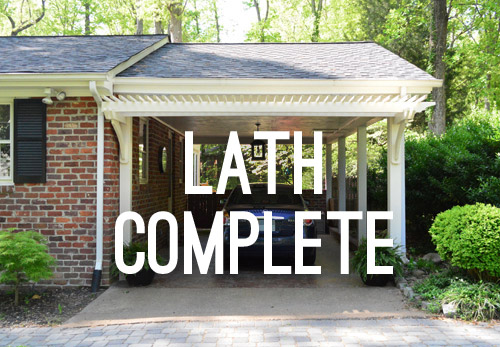
And with that, we could step back and enjoy our gussied-up carport. How YOU doin?
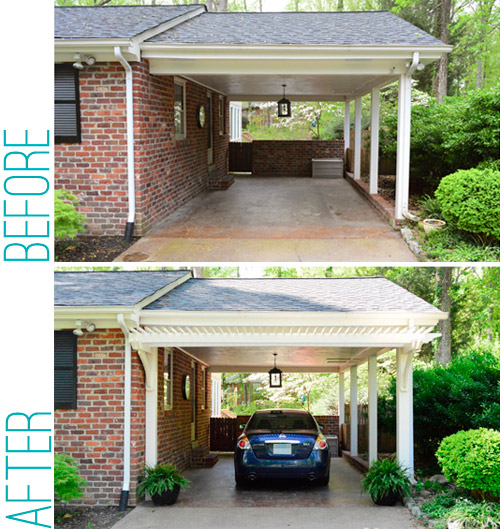
We’re both crazy happy with how it turned out. We were nervous (well, I was nervous) because it wasn’t the most conventional spot for a pergola – but it really is a huge upgrade. Suddenly that parking space tacked on the end of our house has some character. It has actually turned two anti-carport people (remember we almost didn’t look at this house just because it had one) into carport lovers. Well, cargola lovers.
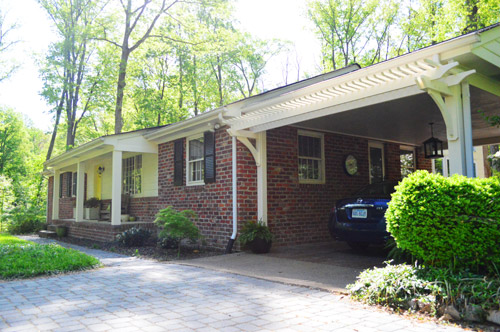
Despite being a bit tedious, none of the labor was really that back-breaking. And the DIY price can’t be beat – especially when we heard that custom attached pergola kits are being sold for over 2K! Here’s where ours wound up:
- Truck rental (to get materials home): $19
- Lumber: $112
- Post bases: $23
- Nuts, bolts, & screws: $46
- Materials to reroute gutter & light: $14
- Paint & primer: Already owned
- TOTAL: $214
Oh and if you have a carport that already has two columns (or a garage with outside walls to rest the braces on) and you buy the braces instead of building them it would be about 50% easier (and should cut out around 2 days of work). So that’s an awesome option for anyone who wants to instantly cut four steps down to two.
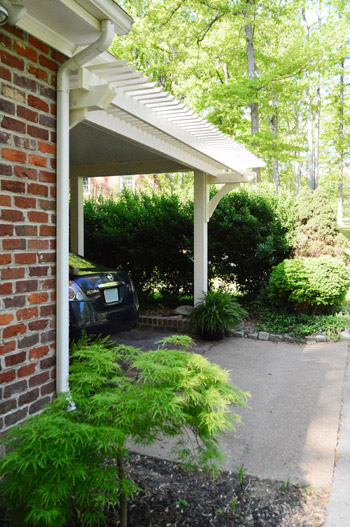
I feel like the new pergola gives our house a bit of “quaintness” (if that’s a word). We especially like how it frames the view of our street, which is currently blooming like crazy. Either way, it definitely adds some nice dimension to our flat ranch.

So yeah, between this and our beefed up porch columns, we’re falling in love with the front of our house all over again. And can you just imagine some flowering vines growing up those posts and across the top of the pergola? Holy charming, batman.
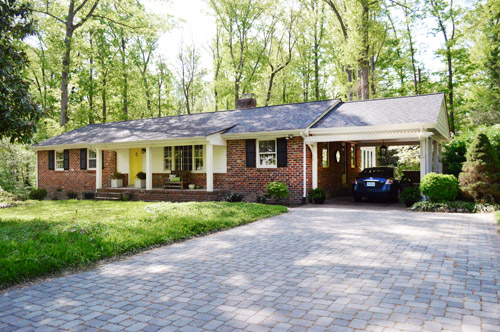
What’s on your outdoor agenda these days?

Aoife says
Love the carogola. Really adds curb appeal. I can just imagine it with your vines growing up it. Great job!
Aoife says
It looks so great that I just had a thought. Would you think of doing another one on the patio side? It would look great from there too. Of course 4 days does make it a big job but it’d be so worth it I think!
YoungHouseLove says
We have some tree branches that might get in the way on that side, but it certainly could be fun to have one on the back too someday!
xo
s
Mary | lemongroveblog says
Holy Smokies!!! I love this so stinkin’ much! We are totally planning on slapping a pergola on our garage as well, not ya got me thinking I want to tackle this sooner rather than later!
Lesley says
Do you have clematis in your neck of the woods? (I swear it’s not an STD…) It’s a popular vine here in Toronto – we are down by the lake where we are apparently in a warmer growth zone than the rest of the city and it does very well for our neighbours.
http://homeofclematis.net/
There are some lovely varieties that grow in your zone (7), but oddly the Virginia Creeper is best suited to Minnesota, North Dakota and Montana… odd.
YoungHouseLove says
Haha oh yes! We actually had that growing around the arch in our first house’s backyard where we got married. Loved it!
xo
s
Julianne says
Wow…it looks absolutely amazing! What an upgrade! I always thought your house and landscaping was really cute and this certainly adds more “umpf” to the curb appeal. Can’t wait to see the foliage growing over it. Great job! :O)
Heidi says
Hubba hubba!! That looks amazing! Can’t wait to see it with some creeping roses or ivy :)
Laura James says
Wow, that is one sexy carportgola!
Kathy S says
Your pergola looks great! Are you going to have something like clematises overtake it? I think that’d be awesome.
YoungHouseLove says
I’d love that!
xo
s
Lisa says
WOW, it looks gorgeous. What a difference that makes. I just recently found your blog and I must say, I Love It. I am enjoying all the projects and tutorials. You are such a cute little family. Thank you so much for sharing all your knowledge :)
YoungHouseLove says
Thanks Lisa! You’re so sweet!
xo
s
Shannon says
great pergolaport, I would suggest a clematis vine. some varieties flower profusely most of spring and early summer and can grow quickly.
YoungHouseLove says
Love that! We had it on the arch at our first house that we got married under :)
xo
s
Tammy says
Nice job – it dresses up the carport in the same manner as mascara dresses up eyelashes.
Erika says
So pretty! Well done!
Melissa@TheHappierHomemaker says
Fancy! Seriously-that was an awesome breakdown of cargola building! Thanks for being so meticulous in your tutorials…it’s so helpful. And it adds so much to your exterior…awesome job (yet again) y’all!
YoungHouseLove says
Aw thanks Melissa!
xo
s
sara says
I cant wait to see vines growing up and around!
andrea says
I feel like the front of your house would look even better if you painted the window shutters white. Have you considered that before?
YoungHouseLove says
Never even thought of that! Definitely will give it some thought :)
xo
s
Autumn Beach says
Ooooh…I like it! And I really like that lantern hanging in there, too.
Carly Cleghorn says
This is hands down awesome! I can’t believe how much of a difference the pergola makes!
Growing up in the south, I’m a bit worn down on the brick ranch look, but the porch column project and this one really make such an impact! The new lines look so intentional and so welcoming–and I bet it’s hard to tell from the street exactly what it is that makes your house so appealing. ;)
vicki says
WOW – just beautiful! And jealous of those mad carpentry skills… and tools! ;)
Lisa C. says
I have a question about the wood. Every time I build something around here with pressure treated wood, I have to look at the unfinished eyesore for weeks and weeks before I can paint it. I didn’t know there was a choice. Exactly what kind of wood did you use, and will the paint be sufficient (or did you use a special sealer?) to keep it from rotting over time?
On the plant front, consider a Lady Banks Rose. It’s a thornless vine that is non-invasive with a small footprint and large head. Comes yellow or white. Won’t pull your pergola down like Wisteria will.
YoungHouseLove says
We have used thick boards of untreated pine with exterior primer and exterior paint (a few thick coats to seal it in well) as well as a thorough caulk-job in all the seams and areas where water could collect with great success on outdoor projects (that’s what we used to rebuild our first house’s porch and 5+ years later it looks great). We also hear cedar is awesome for outside projects if that’s in the budget.
xo
s
lee says
love love LOVE it! Amazing how just a little something makes that area seems more substantial.
i can just see a vine on that YES!
Really love john’s instructions on his economical but even better GENIOUS corbel.
Jenn says
any plans to paint that downspout to the left of the pergola black??? ;-)
YoungHouseLove says
Hmmm, interesting idea. We’ll probably leave it the trim color so it matches the rest of the downspouts though.
-John
Bluenoser says
So nice! And I’m jealous of the lush green of your yard in April. Here in Nova Scotia, we’re just starting to get buds on the the trees.
Melanie says
This looks great! You guys are so talented. Thanks for inspiring the rest of us!
Kim says
Really love this addition. The second column adds balance and the whole thing adds charm and beauty.
We had gorgeous honeysuckle on the front porch at our last house. It offers beautiful flowers, heavenly scent, and it twines around things rather than working its way into crevices–so much safer for your home. An evergreen clematis would be nice. These are NW plants–not sure how they’d fare down South.
Gabbi @ Retro Ranch Reno says
Danggggg, it looks good! I’m loving it! :)
Lindsay O. says
Your carport is now VIP! Very Important Parking! You’re so fancy-schmancy!
Krystle @ Color Transformed Family says
I think it looks great and really finishes off your carport. Pergulas are always a great addition.
Miss Kitty says
FABULOUS John!!! It really does add so much charm to the front of your home. Gosh, just think how much more charming it will be with vines growing up it. I don’t know if this plant does well in VA but I had great results with a plant called a “cross vine” on an arch I had over my front door (on a former house) in Alabama. It only flowers once a year for a couple of weeks but the green foliage is great all year (and it lived through me as an owner…a big plus…I’m more of a “get tough or die” gardener).
Emilie LaRue says
I LOVE IT! Such a good idea! GReat work!
Chelsea @ Riding Escalators says
Wow! This seriously looks great! Just adding that post on the other side really balanced the whole thing out! The pergola is an added bonus!
Inspire Me Heather says
Nice job on your carport pergola – it looks great! I’ve got this linked to my pergola DIY post too and I’m going to have to Pin this for my own files, I’d love to do one too!
Angie - Garage Builder says
That is just amazing. What a huge difference. It adds so much to the house and makes it look so charming and relaxing. Makes the house enjoyable to look at and stands out completely now! Thank you for posting!
Peter says
Hey guys, The pergola looks really great! It really adds a lot to the front view of the carport. In the future though please please please use pressure treated lumber when working outdoors. No amount of primer and paint is sufficient to protect untreated pine. It will rot. It is just a matter of time. Buy pressure treated #1 material from a lumberyard and it will be kiln dried and ready to paint right away. Once again though, it looks great keep it up!
YoungHouseLove says
Thanks Peter! We used it for a porch project on our first house and 4.5 years later it looked great! We were sure to keep the paint coverage nice and thick and whenever we saw anything peel we just went over it with another coat of exterior paint. Pressure treated wood is awesome, but it can’t be painted until it has “dried out” and we didn’t have time to wait for ours to do that in this instance :)
xo
s
Julie says
I spent a good chunk of my labor day weekend on this project, and I have to say that you guys make it look easy (in a good way)! So far all I have completed is a single knee brace, and there may have been some tears involved trying to make all the knee brace bits line up…and it may be a little off in some places. I also realized from looking back at your pictures I didn’t include the filler block on the knee brace, and have no idea really how to attach it anyway. Ha!
Thanks for the plans and commentary to help me along, I don’t think I would have tackled this without seeing you guys do it first. Hopefully I’ll get mine finished sometime this week (without any more tears). Mine is going to hang over a sliding door in the back yard – sort of like in the plan pictures.
Julie says
Also, for some reason I’m only now just seeing that it took you guys 4.5 days. For some reason I had it my head that it only took 3 days and I was wondering why I was so slow :-)
YoungHouseLove says
Aw, all the best of luck Julie! Hope it’s awesome and totally worth all the trouble when it’s done!
xo
s
Richard says
Thanks for this. My plan would be a from-scratch shed style (angled) pergola carport, with some skylights to expose daylight to house windows covered by the roof. it seems I could use much of your plan. Any advice?
YoungHouseLove says
Sounds awesome! My advice would be to plan things out a while, get a permit and follow code to the letter, and measure twice & cut once. Generic, but solid advice. Good luck Richard!
-John
Chad Pfeffer says
What a great idea! You are taking something that some might consider a minus in a house, no garage, and making it beautiful! I love it!